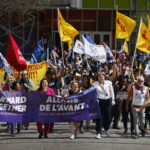In 1983, labour and activist organizations alike across the province, including unions, environmental, religious, social justice and women’s rights groups, came together over the course of several weeks through escalating actions in what would effectively become the largest political protest in BC’s history. (Source: BC Labour Heritage Centre)
In the spring of 1983, British Columbians re-elected the Social Credit Party, headed by William (Bill) Bennett. Within months of taking office, the “Socreds” introduced an austerity budget along with 26 pieces of radically right-wing legislation that included measures to abolish watchdog agencies, attack collective bargaining rights (especially in the public sector), and cut social services.
Opposition to these brazen austerity measures was widespread and popular. It brought the province’s labour movement together with a wide range of social groups, people who relied on social benefits, women, children’s advocates, students, people with disabilities and diverse cultural communities, all of whom felt the full impact of the government’s attack. Led by the BC Federation of Labour (BCFed), unions joined with community organizations to organize a massive public resistance known as “Solidarity”.
Marches and rallies took place throughout the province. Thousands took to the streets with calls for a general strike. The mass firing of government workers slated for October 31st triggered a mass protest the following day as the BC Government Employees’ Union (BCGEU) and its members walked off the job. This snowballed into a series of escalating job actions as the province’s teachers joined the strike the following week with thousands of key pubic sector workers ready to take to the streets in the days that followed.
Recognizing the rapid escalation of the confrontation, the leadership of the BCFed applied the brakes rather than risk an all-out confrontation with the government. Rather than risk the introduction of repressive back-to-work legislation and spreading the work action into the private sector – where there was a risk workers would not join a general strike – they opened a dialogue with the government. On Sunday, November 13, 1983, IWA President Jack Munro met with Premier Bennett and reached a truce, ending the biggest popular protest movement BC has ever seen.
The mass mobilization of “Solidarity” was the start of the fight back against government austerity policies in Canada. Coming together as they did, out of a shared sense of oppression, a sense of unity and common cause developed among the labour, social and civil movements. Yes, there were hard feelings and recriminations in the days that followed labour’s deal to end the protests but they were not enough to smother the sparks of solidarity that resulted in their coming together.
Indeed, many of the key social and political advances made in Canada came about through the solidarity of the labour movement working in common cause with others. To list a few: Medicare, paid maternity leave, legal recognition of same-sex relationships, expansions to the Canada Pension Plan and improvements to Old Age Security, paid leave for victims of domestic abuse, and – in the near future, a National Pharmacare Plan.
Solidarity… forever!





